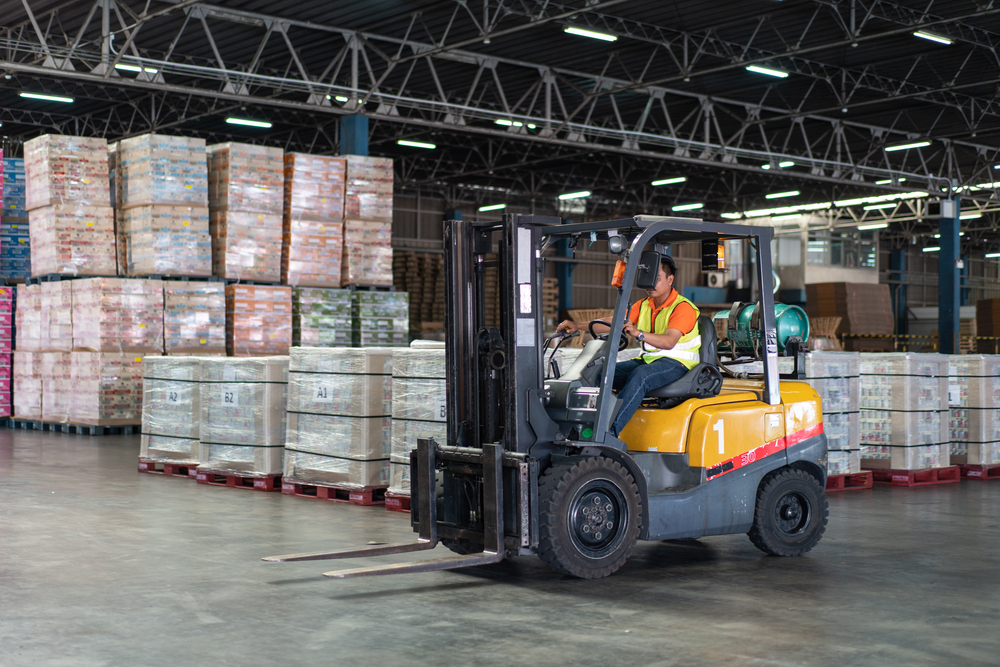In modern logistics, warehousing and manufacturing environments, the forklift (also known as a fork truck, forklift truck or montacarga in Spanish speaking regions) is an essential tool. These machines move goods efficiently, improve workflows and support the structural integrity of the supply chain. But they are also a leading cause of workplace accidents. Understanding the regulatory requirements for operating a powered industrial truck is crucial for maintaining a safe work environment.
Misuse of forklifts can lead to serious accidents so we need to take safety seriously. Proper forklift training is essential in preventing these serious accidents. Operators must complete refresher training and performance evaluations at different stages of their certification process to ensure compliance with OSHA standards. Federal law mandates proper training and certification for forklift operators.
Understanding and following forklift safety procedures is not only a regulatory requirement but part of any responsible company’s operational protocol. Forklift operator training is critical for maintaining safety in various industries. This guide covers the basics of fork truck safety, common mistakes, regulations and practical forklift safety tips to reduce risks, costs and injuries. The Occupational Safety and Health Administration (OSHA) sets safety regulations, and daily inspections of forklifts are required to prevent workplace accidents. Adhering to OSHA regulations, which mandate hands-on practice and evaluation, is essential for full certification.
Download your Forklift Safety Checklist now and strengthen your safety program today
Building a safety culture starts with consistent, actionable steps. That’s why we’ve created a comprehensive Forklift Safety Checklist for you.
The Hidden Dangers of Forklifts
Montacargas are part of our daily industrial life but they are a big risk if not managed with strict adherence to forklift safety rules. According to OSHA, almost 100,000 injuries and 85 deaths occur annually in the US due to forklift related incidents. These are mostly preventable: poor training, lack of enforcement or bad habits developed over time.
The average forklift weighs 9,000 pounds and can lift 1,000 pounds. Slow and small but deadly if mishandled, forklifts can cause serious injury. Unlike passenger vehicles, forklifts are rear wheel driven and have a tighter turning radius so they are more prone to tip over. Tip overs are a major safety concern and are the number one cause of forklift fatalities. Slowing down can prevent such incidents by reducing instability and giving the operator time to stop safely. Forklifts also have big blind spots, reduced braking and instability when carrying elevated loads. You must drive slow and be careful especially when entering or exiting buildings to prevent accidents and be safe. Operators must be aware of the many hazards of operating this heavy equipment. And if an operator is seen operating the vehicle in an unsafe manner, refresher training is necessary.
Forklift Safety Rules: No Excuses
Here are the forklift safety rules to follow daily:
- Only Trained and Certified Operators Can Operate a Forklift: Never let untrained personnel operate a forklift. Operators must go through formal instruction, evaluation and recertification every 3 years or after an incident. OSHA requires this training for safety and compliance. Operators may need refresher training if they are observed operating the vehicle unsafely.
- Daily Inspections Must Be Done: Operators must do a pre-operation inspection to ensure the forklift is safe to use. Check brakes, steering, forks, tires, hydraulic systems, horn and warning lights. Failure to detect a defect can cause severe injury. Regular maintenance checks are also crucial to ensure the forklift remains in good working condition.
- Check the Overhead Guard: Make sure the overhead guard is intact and not modified. This guard protects operators from falling objects and must be maintained as per OSHA standards.
- Respect Load Limits: Every forklift truck has a rated load capacity. Exceeding this limit is very dangerous. Always check the data plate and never guess.
- Never Carry Unauthorized Riders: Forklifts are for one person only. Do not carry co-workers on the forks or anywhere else on the truck. Don’t transport co-workers on forklifts to keep them safe.
- Drive Slow and Follow Speed Limits: Speed kills. Drive slow especially around corners or in tight areas. Keep a safe distance from hazards in the terrain like soft or uneven areas.
- Honk at Intersections and Blind Spots: Not optional. Honk at every blind spot and intersection to alert pedestrians and other vehicles.
- Follow Pedestrian Protocols: Pedestrian zones must be respected. Use mirrors, barriers and designated walkways to avoid collisions.
- Park Safely and Smart: Engage the parking brake, lower the forks and turn off the engine when not in use. Park the forklift in a designated area for safety and efficiency.
Common Fork Truck Violations
Even with rules in place, violations happen. Here are the most common types of forklift accidents:
- No Certification: Lack of firsthand training is a common issue. Forklift operators need to be properly trained and meet OSHA requirements to safely operate a lift truck.
- Skipping Pre-Shift Inspections: Daily inspections are mandatory to catch mechanical issues early. Ignoring them increases the risk of brake failure, hydraulic leaks, or tire blowouts during operation.
- Using Forklifts to Lift People Without Cages: Lifting workers without an approved safety cage is a major violation. Forklifts are not designed for personnel unless equipped with a secure, OSHA-compliant platform.
- Speeding or Sharp Turning: Operating at excessive speed or turning too sharply can cause tip-overs. Forklifts have a high center of gravity and must be driven cautiously, especially with a load.
- Carrying Overloaded or Unbalanced Pallets: Overloading or uneven stacking makes the forklift unstable. Stay within rated load capacities and ensure even distribution to avoid tipping or dropped loads.
- Falling Loads: Improper load handling leads to serious safety risks. Always stabilize and secure your load, keeping within weight and height limits to prevent shifting or falling items.
- Not Using Horns in Blind Areas: Failing to alert others in intersections or blind spots increases collision risks. Always use the horn when visibility is low or when entering shared spaces.
- Body Parts Outside the Operator Compartment: Hanging arms or legs outside the cabin is extremely dangerous. Stay fully inside the operator zone to avoid being struck by obstacles or pinned against structures.
- Operating in an Unsafe Manner: Refresher training is necessary if an operator is observed operating the vehicle in an unsafe manner to ensure compliance with safety regulations.
These violations not only put lives at risk but also can result in big fines from safety regulators.
Forklift Tips for Operators and Supervisors
Implement these forklift tips and you’ll strengthen compliance and safety culture:
- Start with these essential safety tips to ensure a secure work environment and emphasize the necessary skills for safe operation
- Do random spot checks to make sure operators follow procedure
- Update training programs to include real life accident examples
- Encourage near-miss reporting to identify systemic weaknesses
- Assign safety champions in each department to promote accountability
- Fit montacargas with visual and audio warning devices
- Be aware of slippery floors to prevent accidents and ensure safe forklift operation
- Follow safety tips, wear seatbelts and know the safety protocols to operate a forklift safely
- Use hand signals effectively in conjunction with other communication methods to enhance awareness and improve operational efficiency
- Implement strict safety procedures when unloading goods to prevent accidents and injuries
Forklift Safety Requirements in a Multilingual Workforce
In multicultural workplaces we hear the term montacarga instead of “forklift”. Safety training materials must be available in all languages to be understood. This includes signs, training videos and operator manuals. Proper training in all languages is key to reducing operator errors and workplace safety. Operators must be trained and certified according to OSHA standards to meet safety regulations. The training materials meet OSHA standards for general industry, ensuring compliance across various sectors. Miscommunication in this case can be deadly. You must train operators in all languages so they understand and comply with safety protocols, emphasizing occupational safety. This includes training on powered industrial trucks to ensure safe operation and adherence to regulations.
Forklift Safty vs. Forklift Safety: Why Attention to Detail Matters
Misspellings such as “forklift safty” may seem trivial, but they often reflect a lax attitude toward precision — something that should never extend to safety operations. Attention to detail in terminology, procedures, and enforcement is not about bureaucracy — it’s about life and death. This meticulousness is crucial for maintaining a safe workplace. Emphasizing the safe operation of equipment ensures that all safety practices are followed, reducing the risk of accidents.
Forklift Accidents Consequences
Not implementing and enforcing forklift safety rules can result in:
- OSHA fines up to $15,000 per violation
- Legal liability for serious injury or death
- Temporary shutdown of operations during investigation
- Loss of business reputation and client trust
Adhering to OSHA standards is crucial to ensure compliance and avoid these severe consequences. Proper training is essential to recognize the hazards associated with operating a vehicle, specifically forklifts. In areas where montacargas are widely used, local laws may also have additional safety standards. You must comply with both national and local regulations.
Conclusion: Building a Forklift Safety Culture
Forklift safety, fork truck safety, or montacarga safety — whatever you call it — requires more than signs and manuals. It requires a cultural commitment from top to bottom to create a safer workplace. It’s built on consistency, attention to detail and no shortcuts. A forklift operator plays a crucial role in maintaining this safety by adhering to certification and safety practices. Proper conduct and safety measures when operating a forklift are essential to prevent accidents and ensure the safety of both the operator and those nearby.
Forklift safety is everyone’s responsibility. If you operate forklifts, you must ask:
- Are all operators certified and evaluated regularly?
- Are safety inspections documented and reviewed?
- Is safety training ongoing or just a formality?
- Is the equipment properly maintained and in good working condition?
- Is refresher training conducted to maintain safety standards and compliance with OSHA regulations?
The answers to these questions will tell you if you’re compliant or vulnerable.
-
 Maintenance Plan: What Is It And How Does It Work
Maintenance Plan: What Is It And How Does It WorkIn modern manufacturing, equipment downtime costs businesses thousands of dollars an hour. The difference between...
Technology
-
 Competency Management
Competency ManagementModern businesses face a big challenge: how do you ensure every employee has the skills...
Technology
-
 Unlocking the Benefits of Total Quality Management
Unlocking the Benefits of Total Quality ManagementIn today’s competitive world, the quality of products and services is becoming the key to...
Technology
